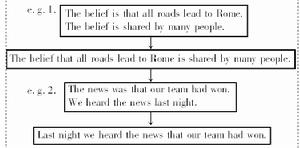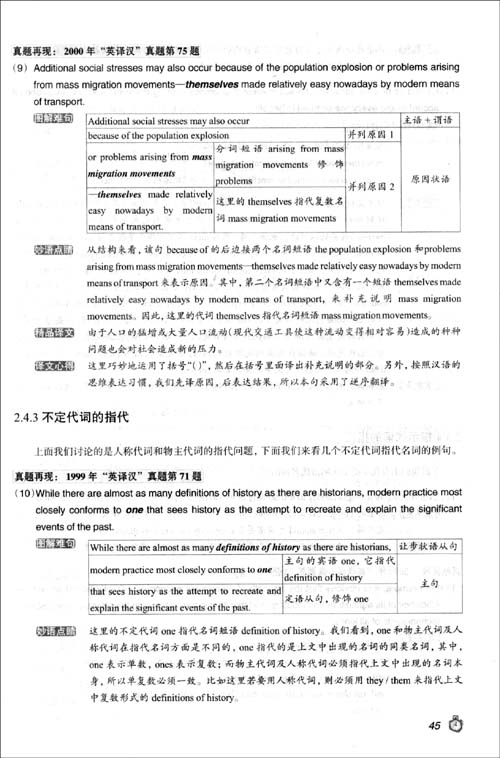用法,名詞作同位語,短語作同位語,直接引語作同位語,句子作同位語,固定用法,引導詞,that引導,whether引導,其它引導詞引導,連線副詞引導,先行詞,引導詞,句式關係,與定語從句,關係,相關語法,位置,形式,語氣,先行詞,特殊形式,
用法 一個名詞(或其它形式)對另一個名詞進行修飾,限定或說明,這個名詞(或其它形式)就是
同位語 。
同位語與被它限定的詞的格式要一致,並常常緊挨在一起。
同位語從句即重複說明同一個稱謂或事件的從句。
名詞作同位語 Mr Wang,my child’s teacher,will be visiting us on Tuesday.
(在這裡'my child's teacher'做同位語修飾'Mr Wang')
短語作同位語 I,the oldest girl in the family,always had to care for the other children.
直接引語作同位語 But now the question comes to their minds,“Did she die young because she was a clone?”
但是現在他們不得不思考這樣的問題:“多莉早死是因為它是一隻
克隆羊 嗎?”
句子作同位語 The girls were surprised at the fact that ocean ships can sail up the Great lakes.
巨大的海輪可以開到
五大湖 ,讓表姐妹倆感到吃驚。
固定用法 同位語部分是個句子,就是同位語從句,這種用法比較"固定"
一、在 複合句 中用作同位語的從句叫同位語從句。它一般跟在某些名詞後面,用以說明該名詞表示的具體內容。 I heard the news that our team had won.
二、可以跟同位語從句的 名詞 通常有news,idea,fact,promise,question,doubt,thought,hope,message,suggestion,words(訊息),possibility,decision等(一般的“抽象”名詞都可用)。 I’ve come from Mr wang with a message that he won’t be able to see you this afternoon.
三、 英語 中引導同位語從句的詞通常有 連詞 that,whether,連線代詞what,who。連線 副詞 how,when,where等。(註:if不能引導同位語從句。) He must answer the question whether he agrees with it or not.
四、有時同位語從句可以不緊跟在說明的名詞後面,而被別的詞隔開。
The thought came to him that maybe the enemy had fled the city.
引導詞 同位語從句的
引導詞 ,引導同位語從句的詞語通常有連詞that,whether,
連線代詞 和連線副詞等。
that引導 that連線從句時從句為一個句意完整的陳述句。that不能省略,沒有具體的意思,不充當句子成分,只起連線作用。
同位語從句 (註:引導同位語從句的that不能省略)
The idea that you can do this work well without thinking is quite wrong.
【注意1】在某些名詞(如demand,wish,suggestion,resolution等)後面的同位語從句要用虛擬語氣
There was a suggestion that Brown should be dropped from the team.
有一項建議是
布朗 應該離隊。
【注意2】引導同位語從句的連詞that通常不省略,但在非正式文體中也可以省去。
He grabbed his suitcase and gave the impression he was boarding the Tokyo plane.
whether引導 (註:if不能引導同位語從句)
The question whether we should call in a specialist was answered by the family doctor.
【注意】whether 可引導同位語從句,但if不能引導同位語從句。
其它引導詞引導 連線代詞 what,who,whom,whose,which,引導同位語從句 1)I have no idea what size shoes she wears.
我不知道她穿幾號的鞋。(what作定語)
2)The question who will take his place is still not clear. (who作主語)
連線副詞引導 連線副詞when,where,how,why
We haven’t yet settled the question where we are going to spend our summer vacation.
先行詞 1.
定語從句 的
先行詞 是名詞或
代詞 ;而同位語從句的先行詞只能是名詞,而且僅限於idea,plan,fact,theory,promise,hope,news,doubt,truth,information,suggestion,question, thought,belief,conclusion等少數名詞。
同位語從句 例如:
①The boy who is playing football who work hard that he had not said anything that you are talking about
在①句中,加粗部分是定語從句,其先行詞是名詞 boy,是具體名詞,它不能用作同位語從句的先行詞。
由以上分析可見,同位語從句的先行詞一定可以用作定語從句的先行詞,但定語從句的先行詞不一定能用作同位語從句的先行詞。
2.when,where,why引導的定語從句的先行詞一定分別是表示時間、地點和原因的名詞,而三者引導的同位語從句的先行詞則肯定不是表示時間、地點和原因的名詞。
例如:
①I still remember the day when I first came to Beijing when she will be back
在①句中,加粗部分是when引導的定語從句,其先行詞day是表示時間的名詞;
引導詞 定語
從句 和同位語從句共同的
引導詞 有四個:that,when,where,why。下面把四個引導詞分成兩類說明它們在兩種從句中的不同用法。
1.引導詞that
引導定語從句的that叫做
關係代詞 ,它除了起連線作用,還在定語從句中充當一定成分,並且在意義上代表先行詞;引導同位語從句的that叫做
從屬連詞 ,它只起連線作用。不能省略。
例如:
①The news that you told me yesterday that our team had won
在①句中,加粗部分是定語從句,that在從句中作
賓語 ,在意義上指代先行詞news。
在②句中,加粗部分是同位語從句,that沒有任何意義,只起連線作用。
2.引導詞when,where,why
引導定語從句時,它們叫做
關係副詞 ,在從句中充當
狀語 ,可以轉換成"介詞+關係代詞"的形式;引導同位語從句時,它們叫做
連線副詞 ,在從句中充當狀語,但不能轉換成"介詞+關係代詞"的形式。
例如:
①I will never forget the day when I joined the army when she was born
在①句中,加粗部分是定語從句,when在從句中作狀語,它可以轉換成on which的形式;
③This is the house where I lived two years ago where the meeting would be held
在③句中,加粗部分是定語從句,where在從句中作狀語,它可以轉換成in which的形式;
⑤This is the reason why she will not attend the meeting why Jack was absent
在⑤句中,加粗部分是定語從句,why在從句中作狀語,它可以轉換成for which的形式;
句式關係 與定語從句 that 既可引導同位語從句又可引導定語從句,其區別在於:1.同位語從句由連線詞that引導,連線詞that本身無意義,在同位語從句中不充當任何成分,不可省略,不可以用其他詞替代;2.定語從句由
關係代詞 that引導,關係代詞that在從句中充當一定的成分,作賓語時可省略.
由when,where,why引導的 同位語從句和定語從句的區別在於:同位語從句由
連線副詞 只起連線作用,沒有指代作用; 定語從句由
關係副詞 引導,關係副詞具有指代先行詞的作用,常用一個介詞加關係代詞替換。例如:I will never forget the day
when we first met . (定語從句,when為關係副詞)
That is the special day
(which/that) I will never forget . (定語從句,which/that為關係代詞,作forget的賓語)
This is the house
where we lived fifteen years ago . (定語從句,where為關係副詞)
This is the house
which we sold fifteen years ago . (定語從句,which為關係代詞,作sold的賓語).
關係 1. 意義的不同
同位語從句是用於說明所修飾名詞的具體內容的,它與被修飾詞語通常可以劃等號;而定語從句是限制所修飾名詞的,它的作用是將所修飾的名詞與其他類似的東西區別開來:
We are glad at the news that he will come.
We are glad at the news that he told us.
聽到他告訴我們的這個訊息我們很高興。(that從句是限制the news的內容的,即我們高興只是因為他告訴的這個news而不是其他的news,故that從句為
定語從句 )
2. 引導 詞的不同
what,how,whatever 等可引導同位語從句,但不引導定語從句。
that引導同位語從句時,它不充當
句子成分 ,而引導定語從句時,它作為
關係代詞 ,要么充當定語從句的
主語 ,要么充當定語從句的
賓語 。如上例 that he told us中的that就充當told的賓語。
4. 被修飾詞語的區別
同位語從句所修飾的名詞比較有限,通常有hope,wish,idea,news,fact,promise,opinion,suggestion,truth等,而定語從句所修飾的名詞則非常廣泛。另外,when和where 引導定語從句時,通常只修飾表示時間和地點的名詞,而它們引導同位語從句時卻不一定;又如why引導定語從句,它通常只修飾名詞the reason,而它引導同位語從句時則不一定:
I have no idea when they will come . 我不知道他們什麼時候來。(同位語從句)
I’ll never forg et the days when I lived there..
相關語法 位置 1.一般情況下同位語從句跟在某些名詞(如news,idea,fact,promise,hope,message等)的後面,用以說明該名詞所表達的具體內容。
同位語從句 I’ve come from Mr Wang with a message that he can't visit you this afternoon.
2.有時同位語從句可以不緊跟在它所說明的名詞後,而被別的詞語隔開,在語法上叫做分隔式同位語從句。
The thought came to her that maybe she had left the door open when she left home.
形式 同位語從句前的名詞通常用單數形式,並且往往帶有
限定詞 (word除外)加以修飾。
Where did you get the idea that I could not come?
語氣 在suggestion,advice,request,order等意為“建議;命令;要求”的名詞後,同位語從句中的
謂語動詞 通常用“should +
動詞原形 ”的虛擬語氣結構,句中的should可以省略。
Our teacher gave us some advice how we(should)use the computer.
先行詞 同位語從句的
先行詞 通常是抽象名詞,常見的有:idea,situation thought,fact,evidence,belief,doubt,fear,hope,question,theory,news,order,ability等等。
How did the cheats explain the fact that the Emperor didn't feel the new clothes in him?
代詞 it可用作同位語從句的先行詞。這個it常放在某些
動詞 或短語動詞後作
賓語 ,同時兼作其後that同位語從句的
先行詞 。
I owe it to you that I am still alive.
有的語法學家把先行詞it後的that從句看作是動詞或
介詞 的真正賓語。一般認為,這種it後的that 從句應看作it的
同位語 ,因為它相當於“
主語 +be+
表語 ”結構。
You must see to it that the children don't catch cold.(=You must see to it,and It is that the children don't catch cold.)
特殊形式 1.間隔同位語從句
同位語從句通常是跟在它解釋或說明的名詞後,但有些情況下,由於句子結構的原因,同位語
從句 不緊跟在名詞後,而被其他的詞隔開。
A warm thought suddenly came to me that I might use the pocket money to buy some flowers for my mother's birthday
簡析:由於that從句太長,為避免句子失去平衡,此處用了間隔同位語從句
例句:
The story goes that he beats his wife.傳說他打老婆。
The news got about that he had won a car in the lottery.訊息傳開說他中彩得了一輛汽車。
The rumour spread that a new school would be built here.謠傳這裡要蓋一所新學校。
Report has it that the Smith sare leaving town.有傳言說史密斯一家要離開這座城市。
The thought came to him that maybe the enemy had fled the city.他想到可能敵人已逃離這座城市。
The order soon came that all citizens should evacuate the village.不久命令下來,所有居民都必須撤出村子。
2.suggestion/request/order等名詞後的同位語從句用 虛擬語氣 。
She made a request that the doctor(should)be sent for at once.
簡析:suggestion,order,request,proposal,requirement,command,advice,proposition和recommendation等名詞後接同位語從句時,從句中的
謂語動詞 要用“(should+)
動詞原形 ”的形式,其中should一詞可省略。
 同位語從句
同位語從句 同位語從句
同位語從句 同位語從句
同位語從句
